Monica Gagliardi
West Woods School, Hamden
TEACHER'S SNAPSHOT
Course Topics/Big Ideas:
Human-Environment Interaction, Map Reading Skills, Movement of People and Ideas
Town:
New Haven
Grade:
Grade 4
Lesson Plan Notes
William Lanson was an African American activist, engineer, and entrepreneur from New Haven. He played an integral role in the development of two New Haven landmarks designed to improve transportation and commerce: Long Wharf and the Farmington Canal. As an activist, Lanson supported the abolitionist movement, the right to vote for tax-paying African Americans, and the establishment of a college for African Americans in New Haven. He also provided employment and housing to many African Americans in the city, breaking down some racial and economic barriers of the time. New Haven’s Black population elected Lanson “Black Governor” (also known as “African King”) of the city in 1825. Although he was a wealthy, influential man in his time, in the end, he was targeted by those threatened by his success and died with nothing. To this day, many people are unfamiliar with him, his contributions, and his importance to our local history and the development of the City of New Haven.
STANDARDS:
4.Inq.4.d. Present a summary of arguments and explanations with relevant information about a person, event, or issue in a United States region using print, oral, and digital technologies (e.g., reasoning, correct sequence, examples, data, details).
4.Civ.14.a. Illustrate historical and contemporary examples of individuals and groups effecting change in a region (e.g., civil rights, clean air policy, conservation, determination of National Park status, healthcare access, water and land rights).
4.Geo.2.b. Use historical maps and other visual representations to explain how environmental characteristics of a United States region change over time (e.g., population centers, built environment, dams, national parks, ports, military bases).
ESSENTIAL QUESTION
SUPPORTING QUESTIONS
- Who was William Lanson?
- How did his ideas and actions help shape New Haven?
- What happened to him?
- How do events along Lanson’s “lifeline” connect to our lives and world today?
- What will you do to make sure Lanson is remembered?
ACTIVITY
Before the lesson (no pre-teaching):
Distribute the survey to every student in the class and also have them bring the survey home for at least one adult to complete. Make clear that students (or adults) should not Google or research!
Collect the surveys and tally the results (or have the students tally them and represent the results in a graph.)
For the inquiry:
Provide each student with a sketchbook or similar for sketchnoting, collecting research, reflections, and recording further questions.
1. Opening discussion: How are people remembered after they are gone? [Photos, statues, street names, storied from people who knew them, etc. Have students brainstorm a list.]
2. Continue the discussion: Who are some famous/well-known people from Connecticut that you are familiar with? What are they known for?
3. Introduce the Compelling Question: How can someone who was so important to a community in their own time be known by so few people today?
4. Read the brief biography together and have students make notes of details they notice and questions they have.
5. Separate students into small groups to research William Lanson more by looking at him through different lenses. Using the same set of resources from the Toolkit above, students will investigate Lanson as an engineer, activist, and entrepreneur. Each day the groups will change the lens through which they are looking at Lanson.
6. After students have finished their research, they will visualize some of the places related to William Lanson’s life. Using the historic New Haven map from 1830, they will mark:
- Long Wharf (also known as “Union Wharf”)
- Farmington Canal
- “New Township” neighborhood (which included Wooster Square)
- “New Liberia” neighborhood (southeast of Wooster Square, along the banks of the Mill River)
- Almshouse (where Lanson died, penniless)
- Location of the William Lanson statue today (near the intersection of Canal and Lock Streets)
OPPORTUNITIES FOR ASSESSMENT
- Create a class book about William Lanson. Each student will research and design a page illustrating some of what they have learned.
- Students will share a personal reflection in a format of their choice (written paragraph, oral presentation, digital presentation, work of art, poem, etc.) responding to the questions: How do events along Lanson’s “lifeline” connect to our lives and world today? How are you inspired by what he did? How will you make sure Lanson is remembered?
RESOURCE TOOL KIT
William Lanson Survey
Brief Biography of William Lanson
“William Lanson Shaped New Haven” by Stacey Close. Humanities, Winter 2021, Volume 42, Number 1. National Endowment for the Humanities.
“A Canal Worker’s Legacy: New Haven’s First Irish Neighborhood.” The Shanachie. Vol. XXV No. 1, 2013. Connecticut Irish-American Historical Society.

“Connecticut’s Black Governors” by Andy Piascik. February 26, 2021. ConnecticutHistory.org.

“The Successes and Struggles of New Haven Entrepreneur William Lanson” by Peter P. Hinks. February 8, 2021. ConnecticutHistory.org.
“William Lanson Statue Taps Into City’s Black History” by Lucy Gellman. July 10, 2020. Arts Council Greater New Haven.
“Uruguayan Muralist Makes King Lanson Soar” by Brian Slattery. November 6, 2020. New Haven Independent.

“Virtual Reality Artist Makes Walls And Streets Move”
Artist Marc Pettersen created an augmented reality animation in honor of Lanson and the mural on Crown Street by David de la Mano. Site Projects, Inc.
“King Lanson Finds Home At The New Haven Museum” by Lucy Gellman. May 2, 2022. Arts Council Greater New Haven.
“Conviction and Sentence of King Lanson.” Hartford Courant, December 13, 1845, page 2.

Map of the City of New Haven from actual survey by D.W. Buckingham, county surveyor. 1830. New Haven: Jocelyn, Darling & Co. Beinecke Rare Book and Manuscript Library, Yale University.
ADDITIONAL RESOURCES
Places to GO
New Haven Museum, New Haven
Lanson Statue, Lock Street & Canal Street, New Haven
Things To DO
Be like William Lanson! Construct/engineer something designed to solve a problem.
Research someone else from Connecticut history who you feel has not been remembered/memorialized enough and make a proposal for a way to commemorate that person.
Learn more about how New Haven could have been the home of America’s first Historically Black College. Watch the film What Could Have Been (24:39).
Websites to VISIT
Articles to READ
“New Haven’s Long Wharf” by Edward T. Howe. ConnecticutHistory.org.
“New England’s Grand Ambition: The Farmington Canal” by Richard DeLuca. ConnecticutHistory.org.
“City unveils statue of William Lanson, Black engineer and activist” by Simisola Fagbemi. Sep 28, 2020. Yale Daily News.



